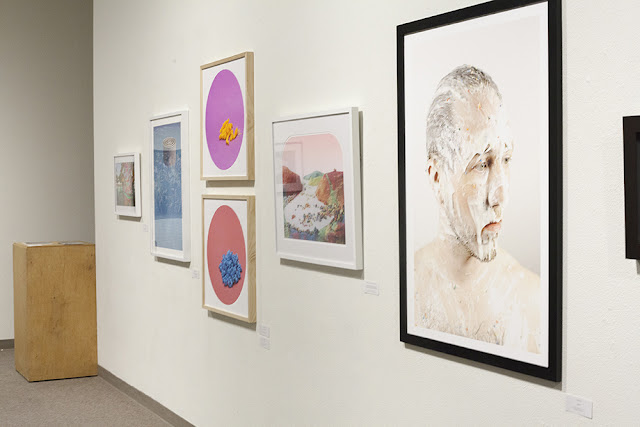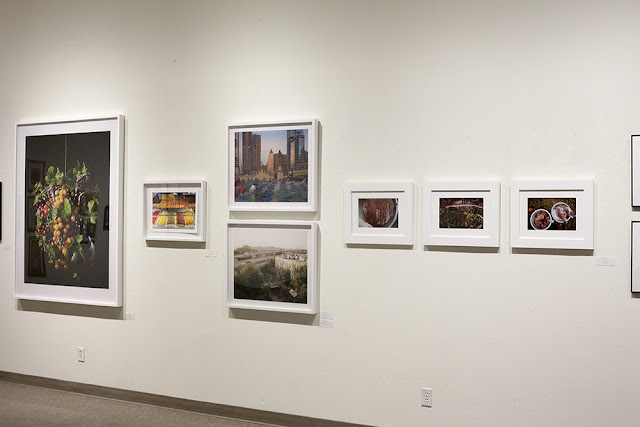 |
| Joyce Elaine Grant Exhibition, 2016 |
Dr. Rebecca Senf is the Norton Family Curator of Photography, a joint appointment at the Center for Creative Photography and the Phoenix Art Museum. She curates three exhibitions a year for the Doris and John Norton Gallery for the Center for Creative Photography in Phoenix and her past exhibitions include Debating Modern Photography: the Triumph of Group f/64; Richard Avedon: Photographer of Influence; Human Nature: the Photographs of Barbara Bosworth; Edward Weston: Mexico; Odyssey: the Photographs of Linda Connor; Charting the Canyon: Photographs by Mark Klett and Byron Wolfe; Face to Face: 150 Years of Photographic Portraiture; Exposing Time: Capturing Change Through Photography and the Steele Gallery exhibition, Ansel Adams: Discoveries of January to June, 2010. Senf grew up in Tucson and went to undergraduate school at the University of Arizona, studying the History of Photography. She spent ten years in Boston, Massachusetts where she earned a Ph.D. in Art History at Boston University. In Boston she worked on the Museum of Fine Arts, Boston’s major exhibition Ansel Adams from The Lane Collection, for which she also co-authored the exhibition catalogue. In October of 2012 her book Reconstructing the View: The Grand Canyon Photographs of Mark Klett and Byron Wolfe was released by University of California Press. Recent projects include exhibitions on the photographic book and two exhibitions focused on platinum photography.
Dr. Senf juried the 15th Annual Joyce Elaine Grant Photography Exhibition at Texas Woman's University, which opened February 15, 2016, and will be on view until March 9, 2016.
 |
| Ciurej & Lochmn, Fruit Loops Landscape |
Joyce Elaine Grant Exhibition Juror’s Statement:
Theme: “Nourish: Food as Sustenance and Pleasure"
Food is the foundation of life; it is sustenance for our bodies and can be the source of great pleasure. We live in a time where food is abundantly available, and yet we have to evaluate grocery store items to determine if what is being offered is actually “real food.” (Fruit Loops, Cheetos, Twinkies, Cheez Whiz. Not real food.)
This is a moment of farm-to-table, locavore, slow food, craft and small batch production, as well as a panoply of ways to describe what we eat, including veganism, pescetarianism, flexitarianism, paleo, and gluten-free. Food (and eating) can be fraught with negative emotions, like guilt, sadness and regret, while at the other end of the spectrum, making food for others can be a profoundly generous and nourishing act. These dichotomous ideas, and range of diets, complicate our relationship to food.
Naturally food has inspired art, and this dynamic selection of works demonstrates that photographers have explored food in all its stages, with a wide range of concerns. Everything from abstracted and aestheticized images of food to pictures that document where our meals come from, these photographs go from appetizing to repulsive, sometimes managing to be both simultaneously.
Grab a napkin, pull up a chair, and find yourself something to eat. Just watch out for the Twinkies.
 |
| Joyce Elaine Grant Exhibition, 2016 |
Interview conducted by: Joy Ellis
Joy Ellis: As an undergraduate, how did you become interested in studying the history of photography?
Dr. Rebecca Senf: I was so fortunate to study at an institution that had a great connection to photography – the University of Arizona in Tucson. My art history classes were taught in the auditorium of the Center for Creative Photography, located within the University of Arizona’s arts campus. As part of the undergraduate art history degree I took a two-semester photo history survey, and just fell in love with the subject. It didn’t hurt that each time I came to class I walked past great photographs, had the opportunity to see amazing photography exhibitions, and studied in a stellar photographic library. Now, I’m back at the Center for Creative Photography as their Norton Family Curator, in a joint appointment with the Phoenix Art Museum. It’s an honor and a privilege to curate for the institution that inspired me as a student.
 |
| Tatyana Bessmertnaya, Harvest |
JE: What spurred your interest in platinum photography? Do you feel that process is relevant in today’s photographic practice? How do you think analog processes change the way photographs are made, seen, shown or discussed?
DRS: I think I’ve always been interested in, and attracted to, platinum photography for its unique physical characteristics and its sheer beauty. I began to consider an exhibition of platinum (and palladium) photography when I realized that the Center had nearly a thousand platinum or palladium photographs, including prints by many of the greats – Peter Henry Emerson, Paul Strand, Edward Weston, Irving Penn, George Tice, Kenro Izu, Lois Conner, Andrea Modica and Scott Davis. I am a curator who is intensely concerned with the physical object, and relished the opportunity to help our audience appreciate how the way in which a platinum photograph is made and its distinctive materials cause it to look different from a gelatin silver print (the typical type of black-and-white photograph). I do believe that platinum photography can be relevant today – if the platinum process is the right physical incarnation for the photographer’s idea. To me, all the alternative or historic processes are valid, but they shouldn’t be used unless the materials and process reinforce the artist’s message or intent. In this moment, where digital photographs are becoming the norm, the choice to use an analog process can carry significant meaning. There are audiences who still appreciate the sensual and physical qualities of photography and who are eager to see crafted objects. Of course, there are those people who see analog photography as “old fashioned” or “traditional” and associate it with a kind of conservative and uninspiring approach to the medium. I would argue, however, that each photograph needs to be assessed for its own merits, including its conceptual rigor and its physical qualities, and individually deemed a success or a failure – without sweeping generalizations about technique, materials or method.
 |
| Julia Kozerski, Breakfast for Two |
JE: For the 15th Annual Joyce Elaine Grant Photography Exhibition, you set the theme: Nourish: Food as Sustenance and Pleasure. What influenced you to develop this specific theme? What was your thought process in selecting work to fit within this theme?
DRS: I chose the topic of food for this exhibition because I’m one of those people who is thinking about dinner... before I’m finished with lunch. All kidding aside, food is something that I find myself frequently reading about and discussing with others. I knew lots of great art projects that dealt with food in one incarnation or another and was eager to learn about more. We received a really wide range of entries and it was exciting to try to represent that diversity in the final exhibition selection. I chose strong examples that represented varied perspectives and approaches to the topic, as well as different photographic styles. The group includes documentary and staged works, pictures that are polished and those that adopt a “snapshot” aesthetic, pictures that are serious and those that are humorous, ones that are abstract and ones that are descriptive. In order to fit the limited space available, I had to leave out many great works but I think the final selection is engaging and dynamic and provides lots of food for thought. (Sorry, I couldn’t help myself with that last pun…)
 |
| Joyce Elaine Grant Exhibition, 2016 |
JE: In the publication of your 2012 book, Reconstructing the View: The Grand Canyon Photographs of Mark Klett and Byron Wolfe, what challenges did you face and how was this process different to curating a gallery exhibition? What were the similarities?
DRS: In creating the book with Mark and Byron there wasn’t really much in common with the process of curating an exhibition – at least, from a nuts and bolts perspective. It was my first time taking a book project from concept to completion, so I was in a steep learning curve all the way through, and I enjoyed seeing my essay go from a collection of words in a computer file to a book that elegantly conveyed Mark and Byron’s body of Grand Canyon work. From a conceptual standpoint there are similarities to curating, such as the fulfilling creative process of going from an idea to a product that can be shared with an audience or the way in which a team of varied experts all work together to create something distinctive. There were lots of great aspects to working on the book. During the research phase, I got to accompany Mark and Byron in the field during one of their trips to the Grand Canyon, which was a dream. Some of the photographs of them at work that illustrate the book are ones I took on that trip. I enjoyed getting to write something more developed and lengthier than my typical curatorial writing. (A typical brochure essay might be 2,000 to 3,000 words, whereas my essay for Reconstructing the View was something like 13,000 words.) Working with a designer, who gave the book a unique look and feel, was a particular pleasure. And I love the permanence of a book as compared to the ephemerality of a museum exhibition.
 |
| Joyce Elaine Grant Exhibition, 2016 |
 |
| Joyce Elaine Grant Exhibition, 2016 |
 |
| Joyce Elaine Grant Exhibition, 2016 |
 |
| Joann Chaus, Breakfast |
 |
| Rob Stephenson |
 |
| Rebecca Foley, Food Phobias |
 |
| Lydia Panas, Cornish Game Hen |

No comments:
Post a Comment